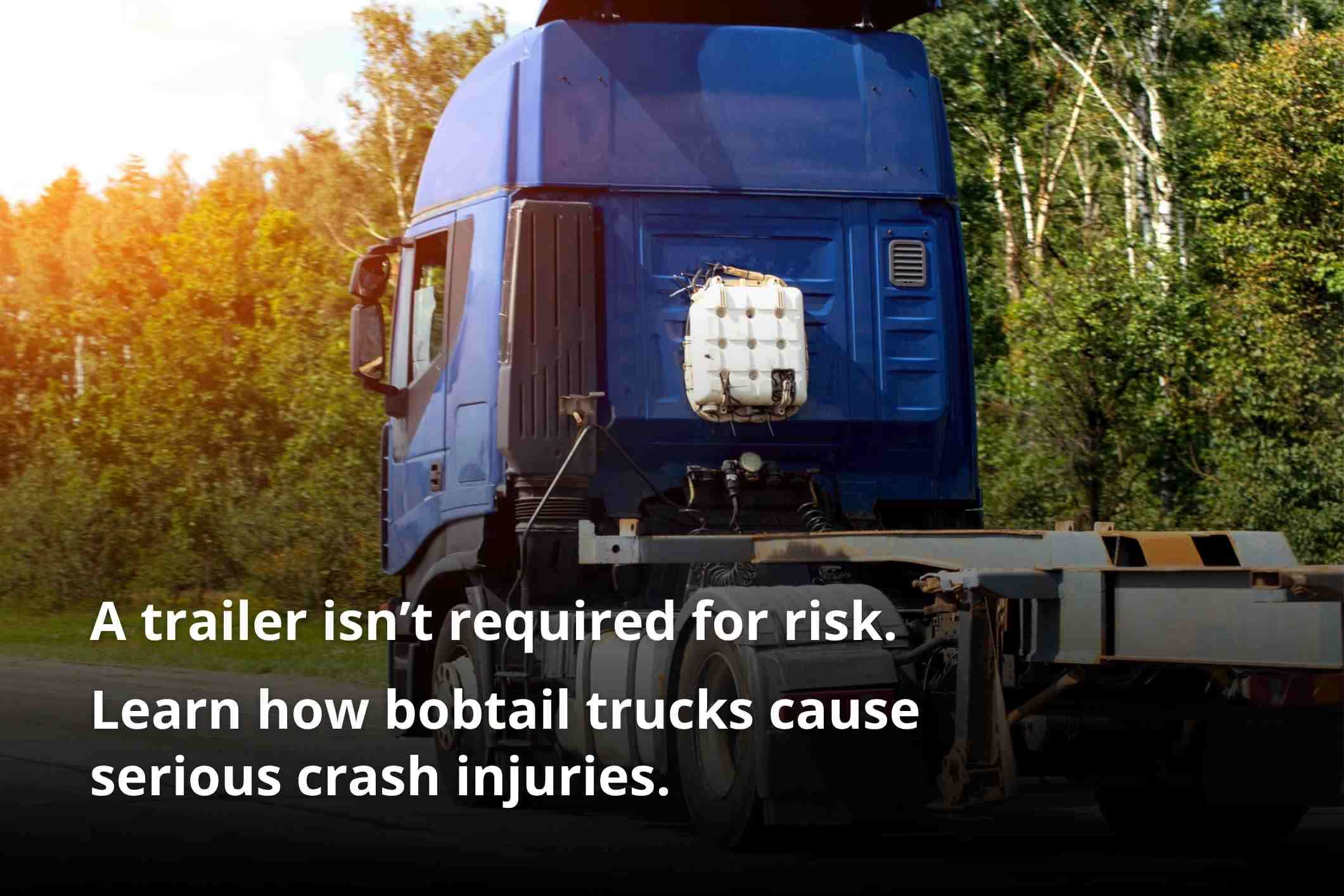What Is Bobtailing?
What Is Bobtailing?

.webp)

Most people think of truck crashes involving big trailers and heavy cargo. But some of the most serious accidents happen when trucks aren’t hauling anything at all.
What is bobtailing? It’s the term used when a semi-truck operates without its trailer attached.
This is common in the trucking industry, typically occurring between deliveries, but it alters how the truck handles itself. Without the trailer’s weight, braking, traction, and stability are all affected, making these trucks harder to control.
If you suffered injuries in a truck crash, you’re not alone. Bobtailing is a known risk in the trucking industry, and when it leads to a collision, the driver or company may be responsible for what happened.
Call Smith Law Center at (757) 244-7000 if a truck without a trailer caused your injuries. We’ve secured results in cases like these, including a $10 million jury award in a commercial truck crash.
What Does Bobtailing Mean?
Bobtailing refers to the specific condition in which a semi-truck operates with no trailer. The driver is still in full control of the tractor unit, but without the added weight of a trailer and its cargo.
This setup may seem lighter and easier to manage, but it introduces a new set of handling challenges. Trucks are designed to perform best when loaded. The braking system, for example, assumes a certain distribution of weight between the tractor and trailer. Without the trailer, that balance shifts dramatically.
Braking becomes more sensitive, particularly in wet or slick conditions. Turning becomes less stable. The rear wheels of the tractor, which normally support and stabilize the connection to the trailer, don’t grip the road the same way. The result is a large, heavy vehicle that behaves unpredictably in high-pressure situations.
Why Bobtailing Can Be Dangerous
Many people assume that a truck without a trailer is inherently safer. Fewer blind spots, less mass, easier navigation, but bobtailing in trucking comes with serious safety concerns:
- Poor braking performance. Bobtail trucks rely primarily on the front brakes, which weren’t designed to stop the full weight of the tractor on their own. Without the added drag of a trailer and its braking system, the truck may take longer to stop or skid more easily in emergencies.
- Reduced traction. Trailers help weigh down the rear axles, giving the truck better grip on the road. When that weight is gone, the rear tires can lose contact with the surface more easily on inclines, turns, or wet pavement.
- Unstable turns. Turning a bobtail truck requires extra caution. The lighter rear end may swing wide or cause the driver to overcorrect. These errors can lead to rollover accidents or collisions with nearby vehicles.
- Driver fatigue or inattention. Drivers who are bobtailing between loads often view this time as low-stakes travel. They may be less alert or more fatigued after a long delivery route, increasing the risk of human error behind the wheel.
When a crash involves this kind of configuration, those handling issues often become central to the case. Proving what went wrong and why requires a close look at the vehicle, the road conditions, and the driver’s conduct.
When Bobtailing Leads to a Crash
Bobtailing accidents can happen anywhere, but they’re especially dangerous on city streets, off-ramps, and rural highways with tight curves or limited visibility. In many of these cases, a bobtail truck either:
- Rear-ends another vehicle because the driver misjudged braking time;
- Crosses into another lane during a wide or unstable turn;
- Jackknifes, even without a trailer, due to uneven traction;
- Loses control in bad weather or on slick roads; or
- Collides with stopped traffic during a delivery transition.
These crashes often raise complicated legal questions. A driver might have been off duty, between shifts, or operating independently at the time of the accident. Liability may fall on the driver, the trucking company, or both, depending on the circumstances of the trip and who was in control of the vehicle at the time.
Truck drivers and carriers have a duty to operate safely, even when no cargo is involved. Injured in a crash with a bobtail truck? Contact Smith Law Center at (757) 244-7000 or online to speak with an attorney who is experienced in handling these cases.
Why Bobtailing Accidents Are Often More Complex
Unlike an 18-wheeler truck crash, bobtailing accidents involve vehicles that may not look like they’re in service. Without a trailer attached, a bobtail truck can be mistaken for a personal vehicle or overlooked as part of a trucking operation.
But legally, it still qualifies as a commercial motor vehicle if it’s operated under a carrier’s authority or used for business purposes.
That distinction matters in terms of insurance, liability, and the investigation that follows. Some of the questions that must be answered include:
- Was the driver working under a carrier’s dispatch at the time?
- Did the company provide or maintain the vehicle?
- Was the trip part of a scheduled route or empty return leg?
- What kind of training did the driver receive on bobtail handling?
- Were there maintenance or brake issues with the tractor?
At Smith Law Center, we’ve handled high-stakes truck accident cases involving complex factors like these. In one case, our attorneys secured $10 million for a woman who suffered a traumatic brain injury in a commercial truck crash. In another case, we secured $5.2 million for a client who was injured by a negligent tractor-trailer driver.
These outcomes reflect the serious nature of truck crash injuries and the work it takes to hold trucking companies accountable.
Understanding the Bobtailing Definition in Truck Accident Injury Claims
The bobtailing definition is key when insurance coverage is in dispute. Some policies include bobtail coverage automatically, while others require it to be purchased separately.
Bobtail insurance typically applies when the truck is being operated without a trailer and not under active dispatch. In contrast, non-trucking liability (NTL) coverage may apply when the vehicle is being used for personal reasons, such as commuting home.
When a crash occurs during a transition between jobs, the two types of coverage often collide. Trucking companies and insurers may dispute whether the driver was on duty, acting within the scope of employment, or using the vehicle for personal purposes. These disagreements can delay claims or reduce compensation.
In many of these cases, a central question becomes: what is bobtailing, and was the driver engaged in it at the time of the crash? The answer can affect how insurance applies and whether the trucking company shares liability.
Our attorneys examine the details—logs, dispatch records, and insurance policies—to obtain clear answers and push back when companies attempt to avoid responsibility. Holding the right party accountable starts with understanding the facts.
Talk to a Truck Accident Attorney Who Knows the Risks
Bobtailing may be a common part of the job in commercial trucking, but that doesn’t mean it’s without danger. Drivers must take extra precautions when operating without a trailer, and trucking companies must ensure their equipment, training, and supervision meet the standards required for safe operation.
When those standards aren’t met, and someone is seriously injured as a result, legal action may be the only way to hold the responsible party accountable.
For over 70 years, Smith Law Center has represented people with life-altering injuries from truck crashes, including cases involving bobtail trucks. We prepare every case for trial and fight for results that reflect the full extent of the harm done, both physically and financially, as well as personally.
Call (757) 244-7000 or contact us online to schedule a free case review with a truck accident attorney today.
About Smith Law Center










